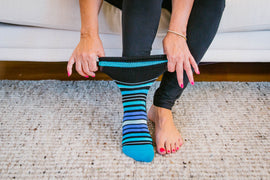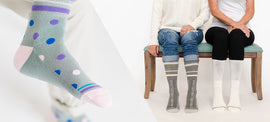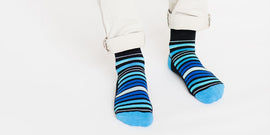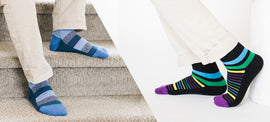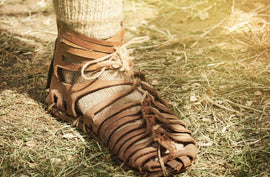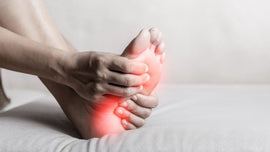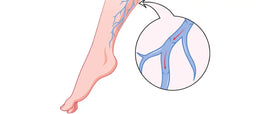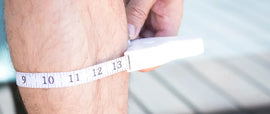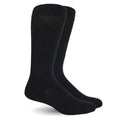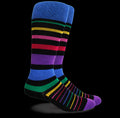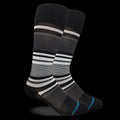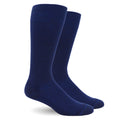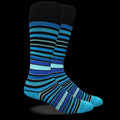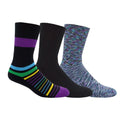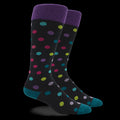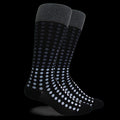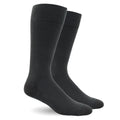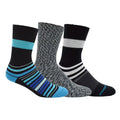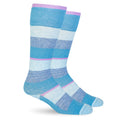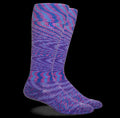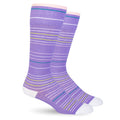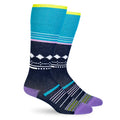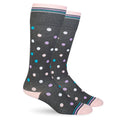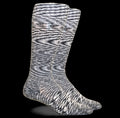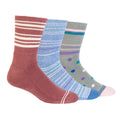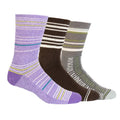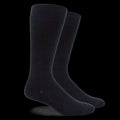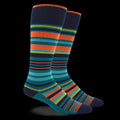What Do Compression Socks Do?
Posted by SIMON LIM

Have you ever thought to yourself, "what do compression socks do?" or even "what level of compression socks do I need?" If they sound like something only old ladies would wear, you might be losing out on the benefits of these affordable and practical apparel pieces.
So, what do compression socks do?
Compression socks increase the tissue pressure beneath the skin by gently squeezing the legs. This reduces excess fluid leakage from the arteries, increasing the absorption of tissue fluid by the veins and lymphatic vessels.
The result is reduced swelling in the legs and feet and swelling prevention. It also reduces the ability of superficial veins to expand to fill with blood, which prevents that blood from flowing backward and causing congestion.
If blood pools in the veins of the legs, that can cause a variety of problems, including skin changes, varicose veins, inflammation of the vein called phlebitis thrombophlebitis, damage to vein walls and valves, and even blood clots.
How Compression Socks Work
Compression socks work by applying pressure to your legs, allowing your blood vessels to function more efficiently. The arteries can be relaxed, allowing blood to circulate freely throughout your body. The veins are given a boost, which helps return blood to the heart.
Using compression socks makes it possible to keep your legs from becoming tired and achy. They can also reduce swelling in the feet and ankles and prevent and treat spider and varicose veins. They may even prevent you from feeling light-headed or dizzy when you first get out of bed in the morning.
When To Wear Compression Socks

There seems to be a lot of confusion about the best time to wear compression socks. Some people think that they are only for athletes or people recovering from an injury. However, this is not the case at all! Wearing compression socks can be beneficial for just about anyone.
There are a few different times when compression socks may be beneficial. First, if you are sitting or standing for long periods, compression socks can help to reduce the risk of blood clots forming. They can also be helpful if you frequently travel, as they can help reduce swelling during flights or car rides. Many people find that compression socks are useful in reducing muscle fatigue after exercising.
Additionally, compression socks can also be helpful to pregnant women and those who have veins problems or are at risk of developing them.
Different Types of Compression Socks

Generally, there are three different types of compression socks:
- Graduated compression socks are the most common type that people choose to wear. These socks, which come in various compression levels - are tightest at the ankle and gradually loosen as they move up the leg. Graduated compression socks typically come in two lengths, knee-high and thigh-high.
- Anti-embolism socks. This type of compression sock is specially designed to maintain good circulation. Bedridden individuals, particularly those recovering from surgery, can use these to help keep blood flowing and therefore avoid blood clots.
- Non-medical Support Hosiery. This type of sock is an alternative to prescription compression socks that offer the same support level but with a more comfortable fit. Those who suffer from painful, tired legs can benefit from this compression socks.
How Do You Know What Size Compression Socks To Buy?
Compression socks are a great way to improve circulation, reduce swelling, and relieve pain. But with so many different types, sizes and brands on the market, it can be tough to know which pair is right for you. Here are a few things to keep in mind regarding how to choose the right compression socks.
- Consider your needs. Be precise with what you are looking for in compression socks. Is it to relieve pain from a medical condition or improve your physical activity performance?
- Consider the level of compression. Compression socks come in different compression levels, from light to extra firm. Choose a pair that will provide the level of support you need.
- Consider the materials. Compression socks are usually made from synthetic materials like nylon or spandex. Some brands also offer socks made from natural fibers like wool.
- Consider the size. Compression socks should fit snugly but not be too tight. Try on a pair before you buy to ensure a comfortable fit.
Choosing the right compression socks can seem daunting with so many factors to think about. But if you keep these things in mind, you'll be sure to find a perfect pair for you.
Benefits of Wearing Compression Socks

There is a long list of the benefits of wearing compression socks, but when you actually think about what do compression socks do, then here are the main advantages you can reap from wearing them.
- Enhance circulation in your legs
- Help avoid venous ulcers and other feet injury
- Decrease leg swelling and fluid retention
- Prevent the development of deep vein thrombosis in your legs
- Prevent blood from pooling in your lower limbs
- Improve lymphatic drainage
- Lessen orthostatic hypotension, which causes lightheadedness or instability when standing
- Support veins and arteries
- Relieve the pain caused by varicose veins and other vein problems
- Provide protection and warmth for the feet
- Support muscle recovery
- Improves athletic performance
Wearing compression socks can help to improve your overall health and well-being. So if you're looking for a way to improve your circulation and reduce swelling, consider investing in a pair of compression socks!
SHARE:




